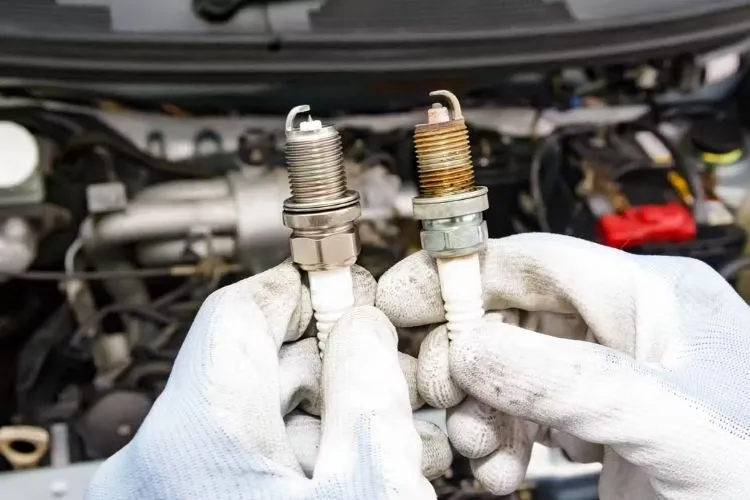Owning a generator requires understanding its maintenance to ensure its longevity and efficiency.
Among the essential maintenance tasks is the replacement of the spark plug, a small but crucial component that significantly impacts the generator’s operation.
This comprehensive guide will take you through the process of how to change a generator spark plug.
Honestly speaking, it’s important to maintain your spark plug in top notch condition, and you should also identify when it needs to be replaced, gathering the necessary tools, and executing the change.
Follow these detailed steps to keep your generator ready for reliable service.

Understanding the Importance of Spark Plug Maintenance
The spark plug serves as the ignition point for the fuel in your generator, directly influencing its ability to start and run smoothly.
A well-maintained spark plug ensures optimal performance, whereas a worn or damaged plug can lead to issues like hard starts, inefficient fuel use, and reduced power output.
Regular maintenance and timely replacements keep your generator running efficiently, providing peace of mind that it will work when needed.
Recognizing the Signs for Spark Plug Replacement

Identifying Wear and Performance Issues
Spark plugs don’t last forever; they wear out and need to be replaced.
Key signs that indicate a spark plug needs changing include difficulty starting the generator, erratic performance, increased fuel consumption, and an overall drop in efficiency.
Regular inspection helps in spotting these issues early.
Following Manufacturer’s Recommendations
Manufacturers provide maintenance schedules, suggesting when to check and replace the spark plug.
These intervals are based on runtime hours and offer a preventive approach to maintenance, ensuring that potential issues are addressed before they escalate.
How To Change a Generator Spark Plug?
Tools and Materials You’ll Need
To change your generator’s spark plug, you’ll require a few basic tools:
- Spark plug wrench or socket wrench
- Gap gauge
- A new spark plug, as specified by your generator’s manufacturer
- Clean cloth or brush for cleaning
Ensure you have the correct spark plug model before starting. The owner’s manual or manufacturer can provide this information.
Preparing Your Work Area
Safety first: make sure the generator is off and cool to the touch. Disconnecting the spark plug wire prevents accidental starts.
Clean the area around the old spark plug to avoid debris from entering the combustion chamber during the change.
Step-by-Step Spark Plug Replacement Process

Removing the Old Spark Plug
Locate the spark plug and use your wrench to gently remove it. Turning it counterclockwise will loosen and remove it. Be cautious to prevent damage to the spark plug’s threading or the generator itself.
Inspecting the Old Spark Plug
Once removed, inspect the old spark plug. Signs of wear, such as electrode damage or heavy carbon buildup, can indicate not only the need for a spark plug replacement but also potential issues within the generator itself.
Setting the Gap of the New Spark Plug
Using a gap gauge, adjust the gap on the new spark plug according to the manufacturer’s specifications. This step is crucial for ensuring that the spark plug ignites the fuel-air mixture correctly.
Installing the New Spark Plug
Carefully thread the new spark plug by hand to avoid cross-threading. Once it’s finger-tight, use the wrench to tighten it to the manufacturer’s recommended torque.
Avoid overtightening, which can damage the spark plug or the cylinder head.
Reconnecting and Testing
Reattach the spark plug wire and ensure it’s securely connected. Once everything is back in place, start the generator according to the manufacturer’s instructions to test the new spark plug’s installation.
The generator should start smoothly if everything was done correctly.
Expert Tips for Spark Plug Maintenance
Double-Check the Gap
Even if a spark plug is marketed as “pre-gapped,” it’s wise to verify the gap against the manufacturer’s specifications. This ensures optimal performance.
Avoiding Over-tightening
Over-tightening the spark plug can strip the threading on the cylinder head, leading to costly repairs. Use a torque wrench if possible to achieve the correct tightness.
Use of Anti-Seize Compound
An anti-seize compound can be applied to the spark plug’s threads to facilitate easier removal in the future.
However, confirm this with your generator’s manual, as it’s not recommended for all engines.
Maintenance Tips for Prolonging Spark Plug Life
Regularly cleaning the spark plug and maintaining your generator according to the manufacturer’s guidelines can extend the life of the spark plug.
Using clean, high-quality fuel and oil also helps minimize deposits on the spark plug, leading to better performance and longer life.
Troubleshooting Common Issues
A spark plug’s condition can reveal much about the health of your generator. For example, a soot-covered spark plug may indicate a too-rich fuel mix, while an oil-coated plug can suggest oil leakage.
Understanding these signs can help in early diagnosis and repair, avoiding larger issues down the road.

When to Seek Professional Help
Changing a generator’s spark plug is generally a straightforward task. However, certain conditions may warrant professional assistance.
If you encounter difficulties or are unsure about any part of the process, consulting with a professional can ensure that your generator remains in good working order.
Frequently Asked Questions (FAQs)
How often should I change my generator spark plug?
Change intervals vary by manufacturer, but a general rule is to inspect the spark plug annually and replace it as needed.
Can I use any spark plug for my generator?
No. Use the spark plug model recommended by your generator’s manufacturer to ensure compatibility and optimal performance.
What signs indicate that my generator’s spark plug needs changing?
Signs include difficulty starting, misfiring, and increased fuel consumption.
Is it necessary to disconnect the generator before changing the spark plug?
Yes, always disconnect the generator to ensure safety.
Conclusion:
The spark plug is a small component with a big impact on your generator’s performance.
Regular maintenance, including timely changes, ensures your generator starts easily, operates efficiently, and remains reliable over its lifespan.
By following this comprehensive guide, you can confidently maintain your generator’s spark usual in top condition, ready to provide power whenever you need it.
Maintaining your generator’s spark usual is a simple yet crucial task that can significantly affect its performance.
By understanding the importance of the spark plug, recognizing when it needs a change, and following the detailed steps for replacement, you can ensure your generator remains a reliable source of power.
Remember, if you ever feel uncertain about performing maintenance, seeking professional help is the best course of action to prevent damage and ensure the longevity of your equipment.
